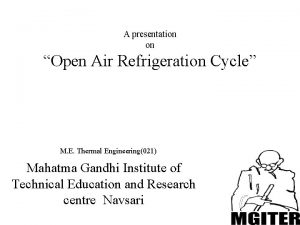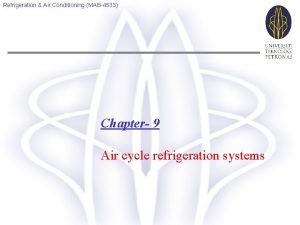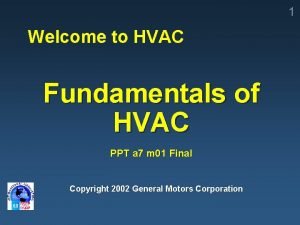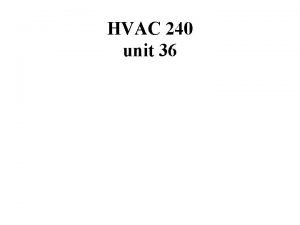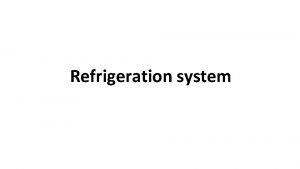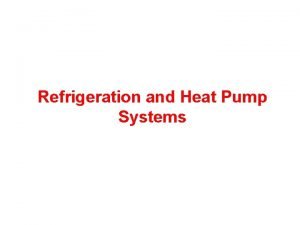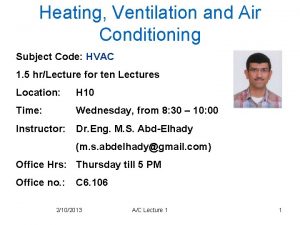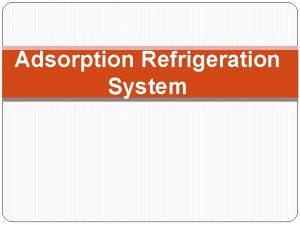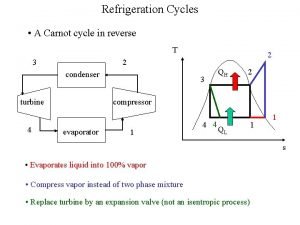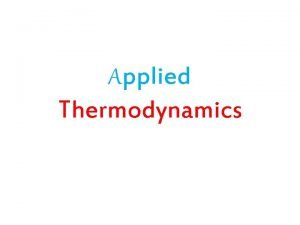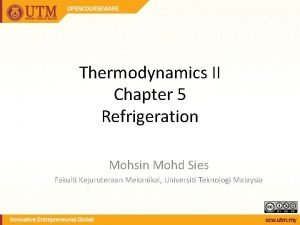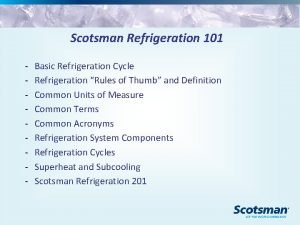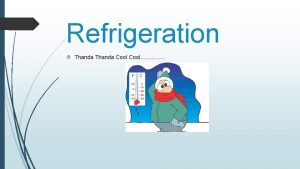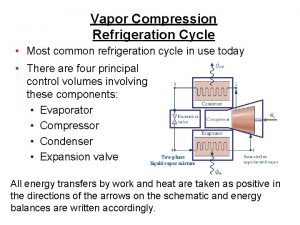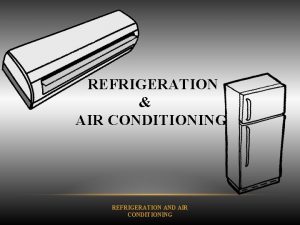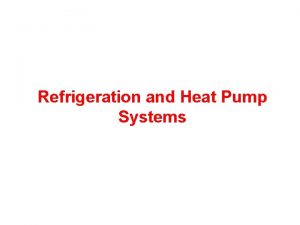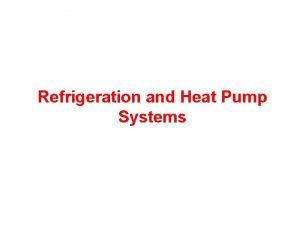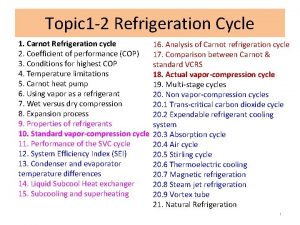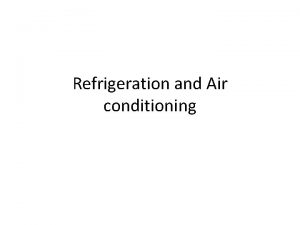A presentation on Open Air Refrigeration Cycle M















- Slides: 15

A presentation on “Open Air Refrigeration Cycle” M. E. Thermal Engineering(021) Mahatma Gandhi Institute of Technical Education and Research centre Navsari

CONTENT • INTRODUCTION • DIFFERENCE BETWEEN A HEAT ENGINE, REFRIGERATOR AND HEAT PUMP • AIR REFRIGERATOR WORKING ON A BELL-COLEMAN CYCLE (OR REVERSED BRAYTON OR JOULE CYCLE)

INTRODUCTION In an air refrigeration cycle, the air is used as a refrigerant. In olden days, air was widely used in commercial applications because of its availability at free of cost. Since air does not change its phase i. e. remains gaseous throughout the cycle, therefore the heat carrying capacity per kg of air is very small as compared to vapour absorbing systems. The air cycle refrigeration systems, as originally designed and installed, are now practically obsolete because of their low coefficient of performance and high power requirements. However, this system continues to be favored for air refrigeration because of the low weight and volume of the equipment. The basic elements of an air cycle refrigeration system are the compressor, the cooler or heat exchanger, the expander and the refrigerator.

Units of Refrigeration Since the latent heat of ice is 335 KJ/Kg, therefore one tonne of refrigeration, 1 TR = 1000 335 k. J in 24 Hours = = 232. 6 Coefficient of Performance of a Refrigerator The coefficient of performance is the ratio of heat extracted in the refrigerator to the work done on the refrigerant. It is also known as theoretical coefficient of performance. Mathematically, Theoretical C. O. P. = Where, Q = Amount of heat extracted in the refrigerator, and W = Amount of work done

Difference between a Heat Engine, Refrigerator and Heat Pump In a heat engine, as shown in fig. the heat supplied t the engine is converted into useful work. If Q 2 is the heat supplied to the engine and Q 1 is the heat rejected from the engine, then the useful work done by the engine is given by W E = Q 2 – Q 1 The performance of a heat engine is expressed by its efficiency. We know that the efficiency or coefficient of performance of an engine, = = =

Fig. 1. Difference between Heat engine, Refrigerator and Heat pump.

A refrigerator as shown in fig. is a reversed heat engine which either cool or maintain the temperature of a body (T 1) lower than the atmospheric temperature (Ta). This is done by extracting the heat (Q 1) from cold body and delivering it to a hot body (Q 2). In doing so, work WR is required to be done on the system. According to First law of Thermodynamics, W R = Q 2 - Q 1 The performance of a refrigerator is expressed by the ratio of amount of heat taken from the cold body (Q 1) to the amount of work required to be done on the system (WR). This ratio is called coefficient of performance. Mathematically, coefficient of performance of a refrigerator, (C. O. P. )R = = Any refrigerating system is a heat pump as shown in fig. which extracts heat (Q 1) from a cold body and delivers to a hot body. Thus there is no difference between the cycle of operations of a heat pump and a refrigerator. The main difference between the two is in their operating temperatures. A refrigerator works between the cold body temperature (T 1) and the atmospheric temperature (Ta) whereas the heat pump operates between the hot body

(T 2) and the atmospheric temperature (Ta). A refrigerator used for cooling in summer can be used as a heat pump for heating in winter. In the similar way, as discussed for refrigerator, we have W P = Q 2 – Q 1 The performance of a heat pump is expressed by the ratio of the amount of heat delivered to the hot body (Q 2) to the amount of work required to be done on the system (WP). This ratio is called coefficient of performance or energy performance ratio (E. P. R. ) of a heat pump. Mathematically, coefficient of performance or energy performance ratio of a heat pump, (C. O. P. )P or E. P. R. = = = +1 = (C. O. P. ) R + 1 From above we see that the C. O. P. may be less than the one or greater than one depending on the type of refrigeration system used. But the C. O. P. of heat pump is always greater than

Air Refrigerator Working on a Bell-Coleman Cycle (or Reversed Brayton or Joule Cycle) A Bell - Coleman air refrigeration machine was developed by Bell-Coleman and light foot by reversing the Joule’s air cycle. It was one of the earliest types of refrigerators used in ships carrying frozen meat. Fig shows a schematic diagram of such a machine which consists of a compressor, a cooler, an expander and a refrigerator. shown on p-v and T-s diagrams in Fig. At point 1, let on p-v and T-s diagrams, v 1, T 1 be the pressure, volume, and temperature of air respectively. The four processes of the cycle are as follows: • Isentropic compression process. The cold air from the refrigerator is drawn into the compressor cylinder it is compressed isentropically as shown by the curve 1 -2 on p-v and T-s diagrams. During this process, the pressure of air increases from p 1 to p 2, specific volume decreases from v 1 to v 2 and temperature increases from T 1 and T 2. We know that during isentropic compression, no heat is absorbed or rejected by the air.

Fig. 2. Bell colemann cycle

• Isentropic expansion process. The air from the cooler is now drawn into the expander cylinder where it is expanded isentropically from pressure p 3 to the refrigerator pressure p 4 which is equal to the atmospheric pressure. The temperature of air during expansion falls from T 3 to T 4. The expansion process is shown by the curve 3 -4 on the p-v and t-s diagrams. The specific volume of air at entry to the refrigerator increases from v 3 to v 4. We know that during isentropic expansion of air, no heat is absorbed or rejected by the air.

• Constant pressure expansion process. The cold air from the expander is now passed to the refrigerator where it is expanded at constant pressure p 4. The temperature of air increases from T 4 to T 1. This process is shown by the curve 4 -1 on the p-v and t-s diagram. Due to heat from the refrigerator, the specific volume of air changes from v 4 to v 1. We know that the heat absorbed by the air during constant pressure expansion per kg of air is



 What is open air refrigeration cycle
What is open air refrigeration cycle Gas cycle refrigeration
Gas cycle refrigeration Air conditioning system ppt
Air conditioning system ppt Unit 36 hvac
Unit 36 hvac Hubungan air dengan tanah
Hubungan air dengan tanah Open innovation open science open to the world
Open innovation open science open to the world Refrigeration process
Refrigeration process Refrigerant cop
Refrigerant cop Refrigeration t-s diagram
Refrigeration t-s diagram Adsorption system
Adsorption system Carnot cycle refrigerator
Carnot cycle refrigerator Matlab refrigeration cycle
Matlab refrigeration cycle Difference between open cycle and closed cycle gas turbine
Difference between open cycle and closed cycle gas turbine What is the working fluid in closed cycle mhd system?
What is the working fluid in closed cycle mhd system? Cascade refrigeration system
Cascade refrigeration system Unit 25 special refrigeration system components
Unit 25 special refrigeration system components
